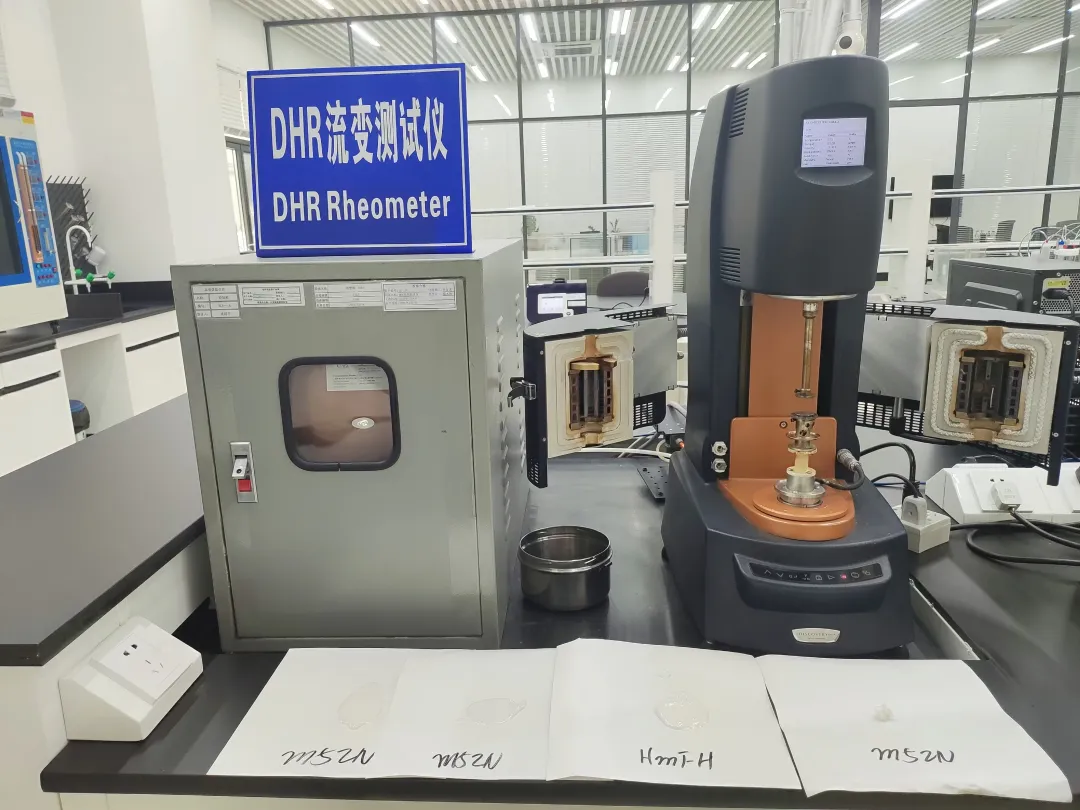-
Precise Control | Excellent Intelligent Manufacturing and Quality Assurance Behind A&E High Precision Testing Tools (Part 2)
Release time:2024-11-24 News section:Company News
-
In the previous report, we provided a detailed introduction to the use and significance of high-precision detection tools such as A&E's "high-precision moisture determination" and "fully automatic refractive index detection". The comprehensive use of high-precision detection tools is an important manifestation of A&E's pursuit of excellent intelligence and quality. They run through the entire production process, from raw material testing to finished product quality evaluation, and every link cannot be separated from their "precise control".
DHR rheological test

Accurate determination of resin viscosity and gelation time is crucial for the production of prepreg. The DHR rheological tester is an important tool for understanding the properties of resins.
Appropriate resin viscosity can ensure uniform distribution of resin between carbon fiber bundles. If the viscosity is too high, it will be difficult for the resin to fully infiltrate the carbon fiber, which will result in areas in the prepreg that are not covered by the resin, thereby affecting the mechanical properties of the product; If the viscosity is too low, the resin will flow excessively, resulting in uneven content. The DHR rheological testing tool can accurately measure resin viscosity to maintain it within the optimal range, thereby ensuring the quality of the prepreg.
Similarly, the determination of gelation time is also of great significance. In the production process of prepreg, layer laying and other operations need to be completed before resin gelation. If the gelation time is not accurate, it may cause the resin to gel prematurely during the operation, making it impossible for the prepreg to form properly; Or if the gelation is too late, it will prolong the production cycle. The DHR rheological testing tool provides key data for optimizing production processes, helping to improve production efficiency and product quality.
Product microstructure analysis

The performance of carbon fiber is closely related to its microstructure, such as its width, thickness, surface roughness, and degree of graphitization inside. We can gain a deeper understanding of the structural quality of carbon fiber through observation under an electron microscope, providing a basis for improving the production process of carbon fiber.
Similarly, we can also perform slice analysis on the finished product to evaluate its internal quality using an electron microscope. The interface bonding between carbon fiber and resin has a decisive impact on the mechanical properties of carbon fiber prepreg and carbon fiber products. By observing the slices, it can be seen whether the carbon fiber and resin are tightly bonded, whether there are pores or delamination phenomena. If poor interface bonding is found, the preparation process of the prepreg can be improved, such as adjusting the resin formula or curing process, to improve the quality of the product.
At present, A&E's R&D Laboratory uses high-definition electron microscopes with observation magnifications up to 30000 times, which play a crucial role in quality control.
Through in-depth understanding of high-precision testing tools, we can see A&E's rigorous attitude and persistent pursuit of quality in the manufacturing process. This almost strict control over details is a key factor for Zhongshan Rongnan's continuous development in the field of carbon fiber intelligent manufacturing. With the silent protection of numerous high-precision testing tools, we will continue to bring more high-quality products to global customers in the future.
-
Related
information
-
-

Excellence in Manufacturing and Quality Assurance Behind A&E High Precision Inspection Tools (Part 1)
Step into A&E and gain a deeper understanding of the high-precision testing tools and methods that safeguard quality.
-

Fashionable and Cool | A&E Carbon Fiber Shared Bike Embarks on a New Trend of Green Travel for Employees
A&E Shared Bicycle, Full of Technological Content
-

Improving Quality with Intelligence | A&E Industrial X-ray Testing Process Protects High end Quality
The use of industrial X-ray equipment for quality inspection of carbon fiber products is an important manifestation of A&E's strict quality control.
-

Accurate and Stable | Revealing the Advantages of A&E Carbon Fiber Baseball Stick Automatic Heavy Filling Process
The automatic gravity filling process highlights its enormous application value due to its advantages in high-precision control, production efficiency improvement, and quality stability.
-



